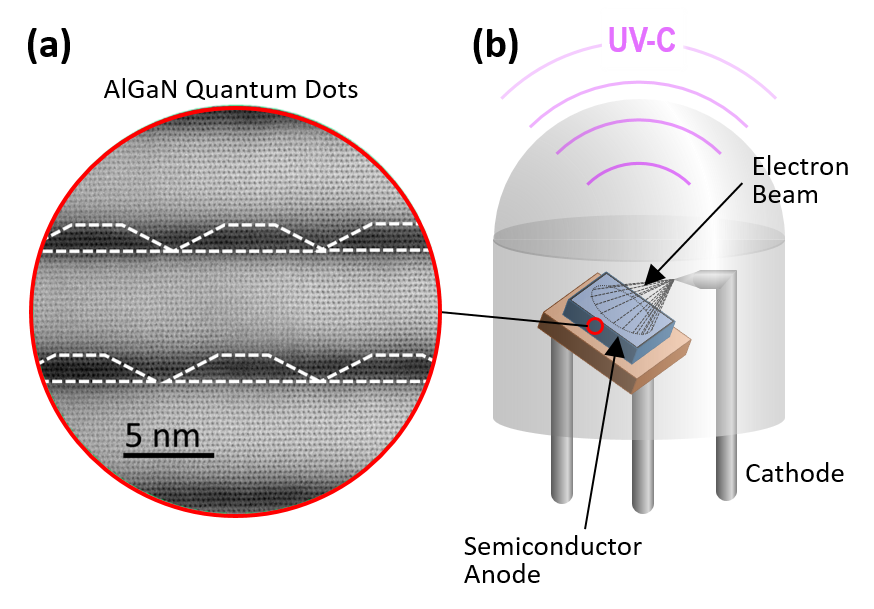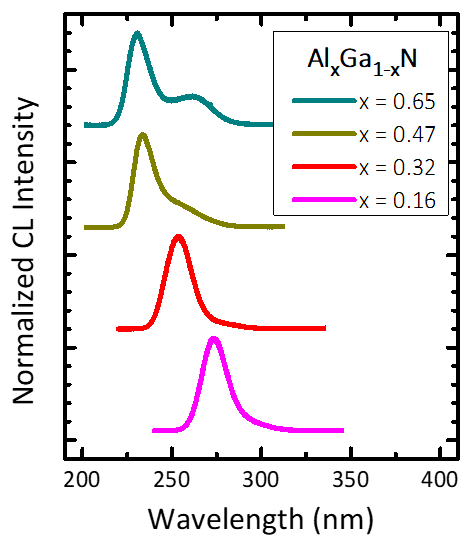Cheap and user-friendly low-pressure mercury lamps, emitting at 254 nm, have played a crucial role in the widespread adoption of UV disinfection technology. However, these lamps present several drawbacks, including a short lifespan, slow switching, and the risk of toxic leaks. The replacement of these lamps with a semiconductor-based technology offers a safer alternative that aligns better with sustainability objectives. Nonetheless, the current performance of AlGaN LEDs, emitting at 270 nm, remains relatively modest, and it gets even worse at shorter wavelengths. In addition to the efficiency issue, LEDs and mercury lamps share the problem that emission at 254-270 nm is strongly carcinogenic and cataractogenic.
In response to these challenges, there has been a recent surge in research for the development of far UV-C sources emitting around 230 nm. This radiation does not penetrate human skin or eyes, making it a safer choice for disinfection in occupied spaces. In this spectral range, an alternative technology to LEDs is electron beam pumped lamps [1], where the electrical power is injected into the semiconductor dice through an electron beam emitted by a cold cathode. This technology has the advantage of not requiring p-type doping or contacts, making it a promising choice for UV-C lighting. Devices powered by electron beams and using AlGaN as the active material have achieved notable improvements in both efficiency and output power. The integration of AlGaN quantum dots holds great promise for further enhancing the performance of these lamps, thanks to the dots’ intrinsically high internal quantum efficiency.
Researchers at PHELIQS, in collaboration with the Institut Lumiere Matiere (University of Lyon), Institut Neel (CNRS) and CEA-LETI, have successfully demonstrated AlGaN quantum dot structures that can be fine-tuned to emit within the 230-270 nm range by adjusting the growth parameters by molecular beam epitaxy. These quantum dots consistently achieve an internal quantum efficiency of approximately 50% across the entire spectral range, and they exhibit power conversion efficiencies that outperform AlGaN LEDs in the 230 nm spectral window [2].
In summary, our research marks a milestone in the development of efficient and safe far UV-C sources for UV disinfection, and provides valuable insights into the potential use of AlGaN-based electron-pumped emitters for this critical application. Our current efforts are concentrated on narrowing the spectral linewidth [3] and improving light extraction efficiency. Furthermore, we are actively working on new cathode designs to extend their lifespan and increase their capacity to deliver high current densities, all with the ultimate goal of enabling the production of safe milliwatt-power lamps for UV disinfection.
Project supported by the ANR agency via the FUSSL (ANR-22-CE09-0024) and ASCESE-3D (ANR-21-CE50-0016) grants.

Figure 1: (a) Bright-field scanning electron microscopy image of two AlGaN quantum dot layers. The quantum dots are closely packed, with a height around 1 nm and a base diameter of 5-7 nm. (b) Schematic description of the targeted UV-C lamp, containing the semiconductor dice with AlGaN quantum dots, and the cold cathode in a vacuum envelop.

Figure 2: Cathodoluminescence (CL) emission spectra of quantum dot samples with different Al concentration in the dots.